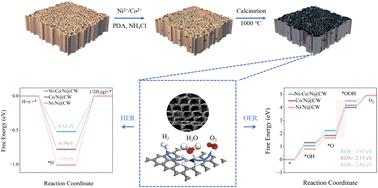当前位置:
X-MOL 学术
›
J. Mater. Chem. A
›
论文详情
Our official English website, www.x-mol.net, welcomes your
feedback! (Note: you will need to create a separate account there.)
Self-supported N-doped carbon-coupled Ni–Co binary nanoparticle electrodes derived from bionic design of wood cell walls for durable overall water splitting
Journal of Materials Chemistry A ( IF 10.7 ) Pub Date : 2024-11-14 , DOI: 10.1039/d4ta06772j Congcong Yang, Ruixi Jin, Zhihang Liu, Shilei Li, Dong Lv, Jingshuo Liu, Jian Li, Zhiqun Lin, Likun Gao
Journal of Materials Chemistry A ( IF 10.7 ) Pub Date : 2024-11-14 , DOI: 10.1039/d4ta06772j Congcong Yang, Ruixi Jin, Zhihang Liu, Shilei Li, Dong Lv, Jingshuo Liu, Jian Li, Zhiqun Lin, Likun Gao

|
Designing high-performance, environmentally friendly, and durable bifunctional electrode materials for electrocatalytic water splitting is a key challenge in implementing sustainable energy technology. Here, we report a bionic modification of wood cell walls inspired by marine mussel adhesive proteins to develop a cost-effective yet high-efficiency wood-based bifunctional electrocatalyst. Ni–Co binary nanoparticles integrated with nitrogen-doped carbonized wood (Ni–Co/N@CW) were prepared by capitalizing on porous wood cell walls as confined spaces. Dopamine was adopted as an adhesive to achieve homogeneous dispersion of the nanoparticles, followed by forming graphitic carbon layers to encapsulate the nanoparticles through a calcination process. Structural and morphological studies revealed that the optimal Ni–Co/N@CW possesses a large surface area, abundant mesopores, and significant N doping in the carbonized wood framework, with 85% of pyridinic N. When employed as both the anode and cathode electrocatalyst in an alkaline medium, the cost-effective Ni–Co/N@CW catalyst manifests outstanding catalytic performance with low overpotentials and robust stability, surpassing the counterparts and recently reported earth-abundant electrocatalysts for both the oxygen evolution reaction (OER; overpotential of 290 mV at 10 mA cm−2) and hydrogen evolution reaction (HER; overpotential of 143 mV at 10 mA cm−2). Most notably, the as-prepared electrode achieves a current density of 10 mA cm−2 at a comparatively low voltage of 1.60 V during overall water splitting in an alkaline electrolyzer. The hierarchically porous structures, advanced mass and charge transport ability (attributed to pyridinic N and graphitic C), and abundant active centers (Ni–Co binary metal sites) collectively unveil a synergistic effect that enhances the water-splitting catalytic activity of Ni–Co/N@CW, as revealed by a series of characterization studies and density functional theory (DFT) calculations. Additionally, the remarkable structural and chemical stability of the hierarchically porous Ni–Co/N@CW results in the (–) Ni–Co/N@CW‖Ni–Co/N@CW (+) water electrolysis cell displaying excellent long-term stability. The development of efficient and economic-friendly self-supported electrodes could contribute to the related energy-conversion systems and advance the progress of biomass-based devices.
中文翻译:

自支撑 N 掺杂碳耦合 Ni-Co 二元纳米粒子电极源自木细胞壁的仿生设计,可实现持久的整体水分解
设计用于电催化分解水的高性能、环保和耐用的双功能电极材料是实施可持续能源技术的关键挑战。在这里,我们报道了一种受海洋贻贝粘附蛋白启发的木细胞壁的仿生改性,以开发一种经济高效且高效的木基双功能电催化剂。通过利用多孔木细胞壁作为受限空间,制备了与氮掺杂碳化木材 (Ni-Co/N@CW) 集成的 Ni-Co 二元纳米颗粒。采用多巴胺作为粘合剂以实现纳米颗粒的均匀分散,然后形成石墨碳层以通过煅烧过程封装纳米颗粒。结构和形态学研究表明,最佳的 Ni–Co/N@CW 在碳化木材框架中具有较大的表面积、丰富的介孔和显着的 N 掺杂,其中 85% 的吡啶氮。当在碱性介质中用作阳极和阴极电催化剂时,经济高效的 Ni-Co/N@CW 催化剂表现出出色的催化性能、低过电位和强大的稳定性,超过了同类产品和最近报道的用于析氧反应(OER;10 mA cm-2 时过电位为 290 mV)和析氢反应(HER;10 mA cm-2 时过电位为 143 mV)的电催化剂).最值得注意的是,在碱性电解槽中的整体水分解过程中,所制备的电极在 1.60 V 的相对较低的电压下实现了 10 mA cm-2 的电流密度。 一系列表征研究和密度泛函理论 (DFT) 计算揭示了分层多孔结构、先进的质量和电荷传输能力(归因于吡啶 N 和石墨 C)以及丰富的活性中心(Ni-Co 二元金属位点)共同揭示了增强 Ni-Co/N@CW 分解水催化活性的协同效应。此外,分层多孔 Ni-Co/N@CW 的显着结构和化学稳定性使 (–) Ni–Co/N@CW‖Ni–Co/N@CW (+) 水电解槽表现出优异的长期稳定性。开发高效且经济友好的自支撑电极有助于相关的能量转换系统,并推动生物质基器件的进步。
更新日期:2024-11-14
中文翻译:

自支撑 N 掺杂碳耦合 Ni-Co 二元纳米粒子电极源自木细胞壁的仿生设计,可实现持久的整体水分解
设计用于电催化分解水的高性能、环保和耐用的双功能电极材料是实施可持续能源技术的关键挑战。在这里,我们报道了一种受海洋贻贝粘附蛋白启发的木细胞壁的仿生改性,以开发一种经济高效且高效的木基双功能电催化剂。通过利用多孔木细胞壁作为受限空间,制备了与氮掺杂碳化木材 (Ni-Co/N@CW) 集成的 Ni-Co 二元纳米颗粒。采用多巴胺作为粘合剂以实现纳米颗粒的均匀分散,然后形成石墨碳层以通过煅烧过程封装纳米颗粒。结构和形态学研究表明,最佳的 Ni–Co/N@CW 在碳化木材框架中具有较大的表面积、丰富的介孔和显着的 N 掺杂,其中 85% 的吡啶氮。当在碱性介质中用作阳极和阴极电催化剂时,经济高效的 Ni-Co/N@CW 催化剂表现出出色的催化性能、低过电位和强大的稳定性,超过了同类产品和最近报道的用于析氧反应(OER;10 mA cm-2 时过电位为 290 mV)和析氢反应(HER;10 mA cm-2 时过电位为 143 mV)的电催化剂).最值得注意的是,在碱性电解槽中的整体水分解过程中,所制备的电极在 1.60 V 的相对较低的电压下实现了 10 mA cm-2 的电流密度。 一系列表征研究和密度泛函理论 (DFT) 计算揭示了分层多孔结构、先进的质量和电荷传输能力(归因于吡啶 N 和石墨 C)以及丰富的活性中心(Ni-Co 二元金属位点)共同揭示了增强 Ni-Co/N@CW 分解水催化活性的协同效应。此外,分层多孔 Ni-Co/N@CW 的显着结构和化学稳定性使 (–) Ni–Co/N@CW‖Ni–Co/N@CW (+) 水电解槽表现出优异的长期稳定性。开发高效且经济友好的自支撑电极有助于相关的能量转换系统,并推动生物质基器件的进步。


















































 京公网安备 11010802027423号
京公网安备 11010802027423号